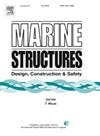Frequency-domain hydroelastic stress analysis considering local bending effect based on a two-step procedure
Abstract
In this study, a two-step stress analysis method to incorporate the global hydroelasticity and local bending effect is developed in the frequency domain. In the first step, the continuous structure is discretized into several rigid modules connected by elastic beams to evaluate global hydroelastic responses, known as the beam-connected-discrete-modules (BCDM) hydroelasticity method. In the second step, the hydrodynamic and hydrostatic pressure as well as inertia forces in step one are mapped on an entire finite element model to estimate the stresses by a quasi-static method. In this method, the boundary value problem solved in the generalized mode is replaced by multi-body hydrodynamics which has been extensively studied. The application of the proposed method is first verified against the results from modal-based method and published experimental data. Then, the effect of local bending and global flexible deformation on the stress is investigated through an intentionally flexible barge with an open-cross section. The results show that the local bending leads to an increase in the stress for some non-resonant frequencies. The global flexible deformation mode contributes significantly to the stress when the resonance vibration is excited, which is caused by the associated inertia forces.

 求助内容:
求助内容: 应助结果提醒方式:
应助结果提醒方式:


